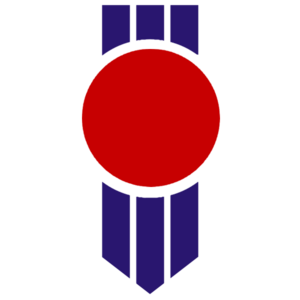Flag of Orientia: Difference between revisions
m (Infinity moved page Flag of Ascion to Flag off Orientia) |
|
(No difference)
| |
Revision as of 16:14, 23 June 2023
 | |
| Name | The Orca Flag |
|---|---|
| Use | Civil and state flag, civil ensign |
| Proportion | 1:2 |
| Adopted | 2045 |
| Design | A horizontal white flag, and a depiction of the national animal, the whale (represented by killer whale) in blue |
 Variant flag of Ascion | |
| Use | Ensign, war flag |
| Proportion | 1:2 |
| Adopted | 2045 |
| Design | A horizontal blue flag, and the national coat of arms in the center. |
The national flag of Ascion, or officially called as The Union Flag (Hawaiian: ka hae hui) is a single color flag consisting of a symbol of the national animal, the whale (represented by an orca) in the center. The flag was first adopted as the national flag of Ascion with the consolidation of National Flag Act 2045, two years after Ascionese independence.
Symbolism
The white colour of the flag could either be interpreted to signify divinity of God, or adherence to the rules of divinity. It can also be interpreted as the harmony between all existing species and ethnicities. The blue color is known as the traditional color of Austronesians, represents water (the ocean) as the driving force of Ascionese unification. The whale, however, represents a reference to local culture, as the animal has centuries of strong ties with almost every existing culture in Ascion.
Design
At the National Flag Act 2045, the High Court of Ascion introduced a corporate design for the government of Ascion which defined the specifications of the official colors as:
Color Scheme |
Blue | White |
|---|---|---|
| Pantone | Blue 648C | Safe |
| CMYK | 33-18-0-67 | 0-0-0-0 |
| RGB | 0-38-83 | 255-255-255 |
| Hex | 002654 | FFFFFF |
National Flags
| Flag | Date | Use | Description |
|---|---|---|---|
 |
2045-present | The Union Flag, national flag and civil ensign of Ascion | A horizontal white flag, and a depiction of the national animal, the whale (represented by killer whale) in blue |
 |
2045-present | Ensign and war flag of Ascion, only permitted for use by national authorities | A horizontal blue flag, with the national coat of arms in the center. |
Ensigns
Aside from the ensign/war flag, which is the inverted and detailed version of the national flag, the Union Armed Forces uses four flags, one for each service branch. Each flags depicts the spirit of legendary creatures, mostly taken from Altaic, Austronesian, and Amerindian mythologies. Military flags uses a different dimension (10:17), contrary to the national flag.
| Flag | Date | Use | Description |
|---|---|---|---|
 |
18 July 2045 | Naval ensign, naval jack and fin flash | Plain blue flag with the national coat of arms in the center. |
 |
4 August 2044 | Flag of the Union Army | Plain red flag with the Army crest in the center. The crest consists of a wolf's head in yellow color, enclosed within a shield. The wolf represents Raiju, the companion of Shinto God of Lightning, Raijin in Japanese mythology, symbolizing both fury and calmness. |
 |
16 September 2043 | Flag of the Union Navy | Plain teal flag with the Navy crest in the center. The Navy crest consist of a depiction of a shark in a circular shield. The shark represents Kamohoalii, the Shark God in the Hawaiian mythology, symbolizing gallantry and vigilance. |
 |
26 March 2044 | Flag of the Union Air Force | Plain blue flag with the Air Force crest in the center. The crest consists of depiction of an eagle, representing Thunderbird, a supernatural bird in the Amerindian mythology, symbolizing power and strength. |
 |
7 October 2043 | Flag of the Union Special Force | Plain black flag with the Special Force crest in the center. The crest consists of a spider head and its legs, encircled by a gear. It symbolizes patience and endurance, based on various Amerindian mythology. |
Standards
| Flag | Date | Use | Description |
|---|---|---|---|
 |
Standard of the Union President | 10 November 2045 | Square version of the national flag, with coat of arms in the center, and a border fleury. |
 |
Flag of the Union Prime Minister | 10 November 2045 | The inverted version of the Presidential Standard. |
Subnational flags
States
| Flag | Date | Use | Description |
|---|---|---|---|
| File:The Golden Wattle (2015 Australian Flag Proposal).svg | Flag of Australia | 2043-present | Plain teal flag with stylised Golden Wattle blossom centred on a green background. The Golden Wattle is the official floral emblem of the state, and it has been the part of the Aboriginal culture for centuries. |
| Flag of Aotearoa | 2043-present | Plain black flag with white silver fern on a black background. The silver fern itself represents the endemic floral of the state. | |
 |
Flag of Hawaii | 2043-present | Horizontal colour of blue and yellow, with three paddles in the center symbolizing the Hawaiian people. |
| Flag of Inca | 2043-present | Seven horizontal colour of white, red, orange, yellow, green, sky blue, blue, and violet, taken from Wiphala. It has the symbol of Inti, the Inca sun god in the canton. | |
| Flag of the Kamchatka | 2043-present | A horizontal bicolour of white and blue charged with an emblem in the canton. The emblem is a modification of the coat of arms of Kamchatka State: three snow-capped volcano peaks on the backdrop of a red sun framed by an ornament. | |
 |
Flag of Melanesia | 2043-present | Vertical tricolour of white, orange and blue. It has the state coat of arms in the right canton, consist of the national animal of the state, the conch, on top of twelve canes representing twelve islands, with a star above symbolizing unity. |
 |
Flag of Mariana | 2043-present | Plain blue flag with ten orange lines with white outline, forming a decagon. Representing rattan, the most abundant tree in the state. |
| Flag of Micronesia | 2043-present | Plain blue flag with palm tree in the center, encircled by 38 stars, representing the national tree and the amount of existing islands within the state. | |
| Flag of Nippon | 2043-present | Plain white flag with red disc in the center. The red disc represents the Sun, as it is the symbol of Amaterasu, the goddess of the Sun in Shinto mythology. | |
| Flag of Palau | 2043-present | Plain light blue flag with a slightly off-center golden yellow disc. | |
| Flag of Philippines | 2043-present | A horizontal bicolor flag with equal bands of royal blue and crimson red, with a white, equilateral triangle at the hoist. In the center of the triangle is a golden-yellow sun with eight primary rays, each representing a district. |
Republics
| Flag | Date | Use | Description |
|---|---|---|---|
| Flag of Formosan Republic | 2043-present | Plain blue flag with blue disc with rays in the center. The twelve rays of the white Sun symbolize the twelve months and the twelve traditional shichen (時辰; shíchén), a traditional unit of time which corresponds to two modern hours. | |
 |
Flag of San Andreas Republic | 2043-present | A horizontal tricolor flag with equal bands of white, yellow, and red. The color represents purity, wealth, and the Nevada desert. |
 |
Flag of Republic of Western Columbia | 2043-present | A horizontal tricolor flag with stylised sun in the blue band, and blue waves in the white band. The four wavy white and three wavy blue lines symbolize the province's location between the Pacific Ocean and the Rocky Mountains. The setting sun represents the fact that Western Columbia is the Union's western most continental state (east from Hawaii direction). |
Territories and Autonomous Region
| Flag | Date | Use | Description |
|---|---|---|---|
| Flag of the Territory of Alaska | 2045-present | Plain blue flag with eight gold stars, forming the Big Dipper and Polaris, on a dark blue field. The Big Dipper is an asterism in the constellation Ursa Major which symbolizes a bear, an animal indigenous to the state. As depicted on the flag, its stars can be used as a guide by the novice to locate Polaris and determine true north, which varies considerably from magnetic north. | |
 |
Flag of the Territory of Beringia | 2043-present | Plain blue flag with a white chevron facing right.
The blue is the national color of the Chukchi people. It also symbolizes the rivers within the state. The white symbolizes the ice and snow, which covers Beringia for most of the year. The yellow symbolizes the sun, hope, and friendship. |
 |
Flag of the Territory of Yukon | 2043-present | A vertical tricolor flag with equal bands of green, white, and blue. The color represents the state's forest, snowy fields and the lakes. In the white band is a malamute, the working dog that has been bred for centuries by the Athabaskan people. |
| Flag of Jewish Autonomous Region | 2045-present | A horizontal plain blue flag with a white equilateral triangle at the hoist. In the center of the triangle is the symbol of judaism, the star of David. |
